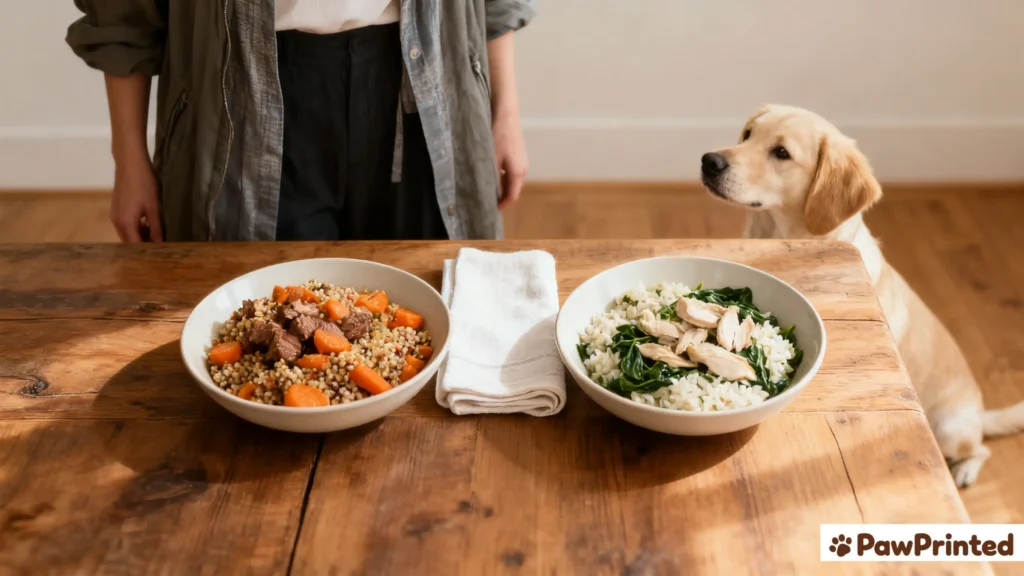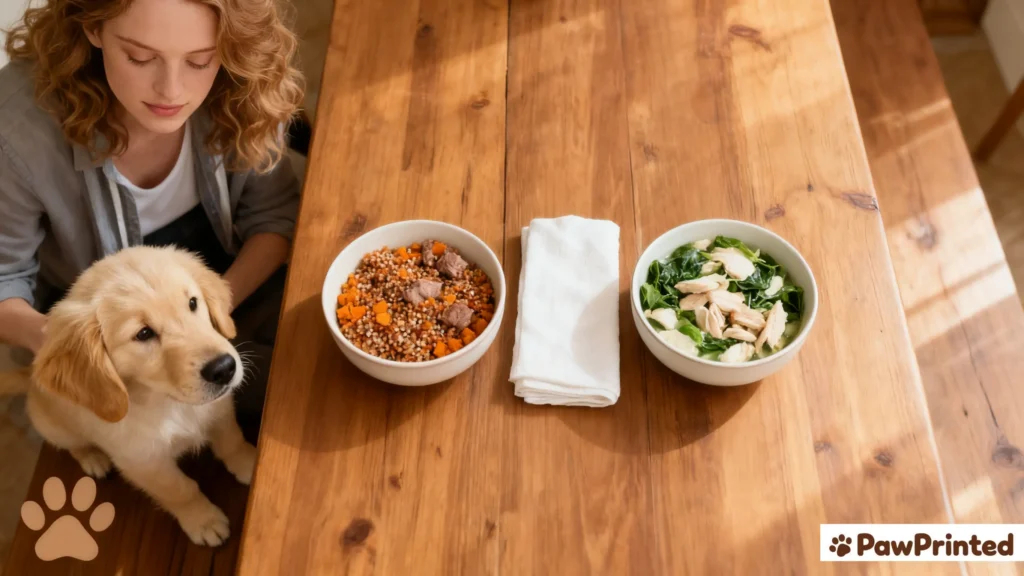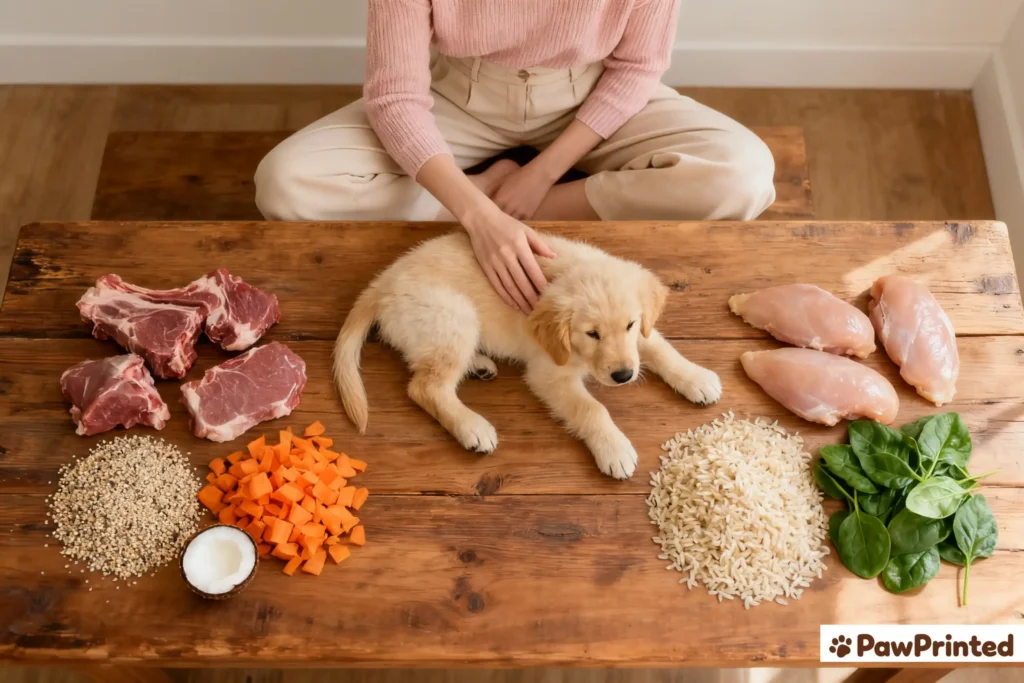When Ethan first started itching and leaving tiny “snow flurries” on the couch, chicken was the last thing I suspected. It’s everywhere in dog food and usually works for most pups. But after a few on-off flare cycles, our vet suggested a reset with a simpler plan and a different protein. That’s when lamb entered the chat—and for Ethan, the switch made our days look calmer and a lot less itchy.
Red flag — call your vet: facial swelling or hives, hot spots, open sores, foul ear odor with pain, or nonstop itching that disrupts sleep. These can signal deeper allergies or infections.

Why Chicken Is Popular (And When It Backfires)
Chicken is affordable, widely available, and naturally palatable. For many healthy dogs, it’s a great day-to-day protein. But because it’s so common, some dogs develop sensitivity or allergy over time. If your dog has recurring itch, soft stools, or ear issues on chicken-heavy diets, consider a structured trial with a different protein plus a limited-ingredient approach.For a broader plan, see our Dog Food for Allergies Guide.
Why Lamb Became a Gentle Alternative
Lamb is often a “novel” or less-commonly used protein for many dogs. In LID recipes, lamb shines because you control variables—one primary protein, simple carbs, and fewer extras. Many pet parents report calmer skin and steadier digestion after a measured switch. Get the big picture in our Lamb Dog Food Guide.

Lamb vs Chicken: Nutritional & Practical Face-Off
| Criteria | Chicken | Lamb |
|---|---|---|
| Protein quality | High-quality, lean; widely tolerated in healthy dogs | High-quality; often palatable for picky eaters |
| Fat profile | Generally leaner; depends on cut/formula | Tends to be richer; can aid satiety & coat (watch calories) |
| Allergy risk | More commonly reported sensitivity due to ubiquity | Often gentler or “novel” for dogs reacting to chicken |
| Digestive response | Stable in many; some dogs show soft stools/itch | Often steadier in LID plans; slow transition is key |
| Cost & availability | Budget-friendly; many options | Usually pricier; fewer but targeted options |
| Best fit | Most healthy, budget-minded households | Sensitive skin/stomach, suspected chicken triggers |
Which Dogs Benefit Most from Lamb?
- Dogs with sensitive skin or recurring itch: Lamb LID formulas reduce variables and often calm flare-ups. See Sensitive Skin Guide.
- Dogs with suspected chicken sensitivity: Switch to lamb for 6–8 weeks while keeping treats simple; then reassess.
- Dogs needing a palatable reset: Lamb’s flavor can help picky eaters stick with a plan.
Curious whether lamb is truly “hypoallergenic”? We break down the term and what it means in real life here: Are Lamb Dog Foods Really Hypoallergenic?

Our Vet’s Take & Ethan’s Story
Our vet asked us to commit to a quiet plan: one lamb-based limited-ingredient base, measured omega-3s, and a 7–10 day transition. Within two weeks, Ethan’s stools were more consistent; by week four, paw-licking eased. Your mileage may vary, but a slow, steady trial tells you more than three foods in three weekends.
When you’re ready to choose a product, we’ve summarized what actually worked for us here: Best Lamb Dog Food.
FAQ
Is lamb better than chicken for allergies?
Often, yes—if chicken has been part of the problem. Lamb works well in LID plans because you can control variables. If symptoms persist, involve your vet and consider a formal elimination diet.
Does lamb dog food help with sensitive skin?
Many itchy pups do better on lamb, especially with measured omega-3s and simple carbs (oatmeal/rice). See our Sensitive Skin Guide for a complete routine.
Is chicken still good for most healthy dogs?
Yes. Chicken remains a solid, economical protein for many dogs without sensitivity. If your dog is thriving on chicken, there’s no need to switch.
What’s the best limited-ingredient lamb food to start with?
Choose a reputable lamb-first recipe with short labels and clear feeding guidance, then transition over 7–10 days. We list our winners here: Best Lamb Dog Food.
Note: Keep everything else boring (treats, toppers) during your protein trial. One change at a time tells you what’s actually working.

Follow PawPrinted on Pinterest
Get side-by-side protein comparisons, allergy-friendly recipes, and vet-approved feeding tips.

